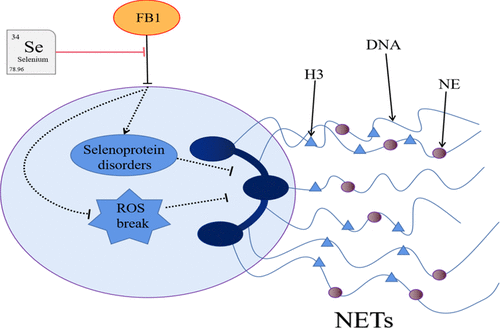当前位置:
X-MOL 学术
›
J. Agric. Food Chem.
›
论文详情
Our official English website, www.x-mol.net, welcomes your
feedback! (Note: you will need to create a separate account there.)
Antagonistic Effect of Selenium on Fumonisin B1 Promotes Neutrophil Extracellular Traps Formation in Chicken Neutrophils
Journal of Agricultural and Food Chemistry ( IF 5.7 ) Pub Date : 2022-05-10 , DOI: 10.1021/acs.jafc.2c01329 Huquan Zhu 1 , Qinfang Yu 1 , Huimin Ouyang 1 , Ruofan Zhang 1 , Jinhong Li 1 , Runxi Xian 1 , Kai Wang 1 , Xinran Li 1, 2 , Changyu Cao 1
Journal of Agricultural and Food Chemistry ( IF 5.7 ) Pub Date : 2022-05-10 , DOI: 10.1021/acs.jafc.2c01329 Huquan Zhu 1 , Qinfang Yu 1 , Huimin Ouyang 1 , Ruofan Zhang 1 , Jinhong Li 1 , Runxi Xian 1 , Kai Wang 1 , Xinran Li 1, 2 , Changyu Cao 1
Affiliation

|
Neutrophils are an important component of the innate immune system, and one of their defense mechanisms, neutrophil extracellular traps (NETs), is a hot topic of the current research. This study explored the effects of fumonisin B1 (FB1) on chicken neutrophil production of NETs and its possible molecular mechanism of action. Scanning electron microscopy and fluorescence microscopy were used to observe morphological changes in neutrophils, and a fluorescence microplate reader was used to detect reactive oxygen species (ROS) and extracellular DNA release from neutrophils. Quantitative PCR (qPCR) and western blot were used to determine the expression levels of selenoproteins. The results indicate that FB1 inhibited the zymosan-induced formation of NETs in chicken neutrophils by preventing ROS burst and histone H3 (H3) and neutrophil elastase (NE) release. Moreover, the mRNA expression levels of glutathione peroxidase (GPX), thioredoxin reductase (TXNRD), and deiodinase (DIO) were downregulated in the FB1 group. The protein expression levels of GPX1, GPX2, GPX3, DIO3, and TXNRD1 were consistent with the changes in their gene expressions, suggesting an abnormal selenoprotein expression in response to the toxic effects of FB1. Conversely, selenium (Se) supplementation reduced the toxic effects of FB1 and restored the NETs formation, indicating that Se can be used as a potential drug to prevent and control FB1 toxicity in livestock farming.
中文翻译:

硒对伏马菌素B1的拮抗作用促进鸡中性粒细胞中性粒细胞胞外陷阱的形成
中性粒细胞是先天免疫系统的重要组成部分,其防御机制之一中性粒细胞胞外陷阱(NETs)是当前研究的热点。本研究探讨了伏马菌素 B1 (FB1) 对 NETs 鸡中性粒细胞产生的影响及其可能的分子作用机制。使用扫描电镜和荧光显微镜观察中性粒细胞的形态变化,并使用荧光酶标仪检测活性氧(ROS)和中性粒细胞的细胞外DNA释放。定量 PCR (qPCR) 和蛋白质印迹用于确定硒蛋白的表达水平。结果表明,FB1 通过阻止 ROS 爆发和组蛋白 H3 (H3) 和中性粒细胞弹性蛋白酶 (NE) 释放来抑制酵母聚糖诱导的鸡中性粒细胞中 NET 的形成。此外,FB1组谷胱甘肽过氧化物酶(GPX)、硫氧还蛋白还原酶(TXNRD)和脱碘酶(DIO)的mRNA表达水平下调。GPX1、GPX2、GPX3、DIO3和TXNRD1的蛋白表达水平与其基因表达的变化一致,表明硒蛋白表达异常是对FB1毒性作用的反应。相反,硒(Se)补充降低了FB1的毒性作用并恢复了NETs的形成,表明硒可以作为一种潜在的药物来预防和控制畜牧业中的FB1毒性。FB1 组中的硫氧还蛋白还原酶 (TXNRD) 和脱碘酶 (DIO) 下调。GPX1、GPX2、GPX3、DIO3和TXNRD1的蛋白表达水平与其基因表达的变化一致,表明硒蛋白表达异常是对FB1毒性作用的反应。相反,硒(Se)补充降低了FB1的毒性作用并恢复了NETs的形成,表明硒可以作为一种潜在的药物来预防和控制畜牧业中的FB1毒性。FB1 组中的硫氧还蛋白还原酶 (TXNRD) 和脱碘酶 (DIO) 下调。GPX1、GPX2、GPX3、DIO3和TXNRD1的蛋白表达水平与其基因表达的变化一致,表明硒蛋白表达异常是对FB1毒性作用的反应。相反,硒(Se)补充降低了FB1的毒性作用并恢复了NETs的形成,表明硒可以作为一种潜在的药物来预防和控制畜牧业中的FB1毒性。
更新日期:2022-05-10
中文翻译:

硒对伏马菌素B1的拮抗作用促进鸡中性粒细胞中性粒细胞胞外陷阱的形成
中性粒细胞是先天免疫系统的重要组成部分,其防御机制之一中性粒细胞胞外陷阱(NETs)是当前研究的热点。本研究探讨了伏马菌素 B1 (FB1) 对 NETs 鸡中性粒细胞产生的影响及其可能的分子作用机制。使用扫描电镜和荧光显微镜观察中性粒细胞的形态变化,并使用荧光酶标仪检测活性氧(ROS)和中性粒细胞的细胞外DNA释放。定量 PCR (qPCR) 和蛋白质印迹用于确定硒蛋白的表达水平。结果表明,FB1 通过阻止 ROS 爆发和组蛋白 H3 (H3) 和中性粒细胞弹性蛋白酶 (NE) 释放来抑制酵母聚糖诱导的鸡中性粒细胞中 NET 的形成。此外,FB1组谷胱甘肽过氧化物酶(GPX)、硫氧还蛋白还原酶(TXNRD)和脱碘酶(DIO)的mRNA表达水平下调。GPX1、GPX2、GPX3、DIO3和TXNRD1的蛋白表达水平与其基因表达的变化一致,表明硒蛋白表达异常是对FB1毒性作用的反应。相反,硒(Se)补充降低了FB1的毒性作用并恢复了NETs的形成,表明硒可以作为一种潜在的药物来预防和控制畜牧业中的FB1毒性。FB1 组中的硫氧还蛋白还原酶 (TXNRD) 和脱碘酶 (DIO) 下调。GPX1、GPX2、GPX3、DIO3和TXNRD1的蛋白表达水平与其基因表达的变化一致,表明硒蛋白表达异常是对FB1毒性作用的反应。相反,硒(Se)补充降低了FB1的毒性作用并恢复了NETs的形成,表明硒可以作为一种潜在的药物来预防和控制畜牧业中的FB1毒性。FB1 组中的硫氧还蛋白还原酶 (TXNRD) 和脱碘酶 (DIO) 下调。GPX1、GPX2、GPX3、DIO3和TXNRD1的蛋白表达水平与其基因表达的变化一致,表明硒蛋白表达异常是对FB1毒性作用的反应。相反,硒(Se)补充降低了FB1的毒性作用并恢复了NETs的形成,表明硒可以作为一种潜在的药物来预防和控制畜牧业中的FB1毒性。









































 京公网安备 11010802027423号
京公网安备 11010802027423号